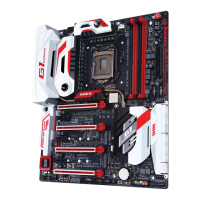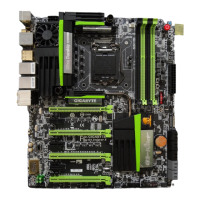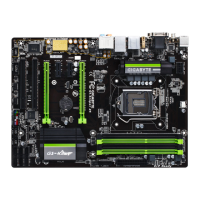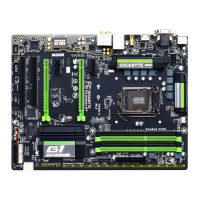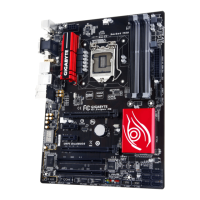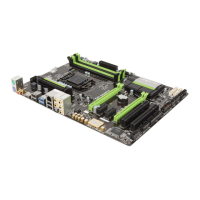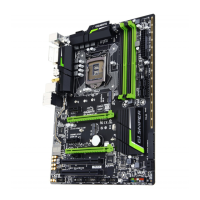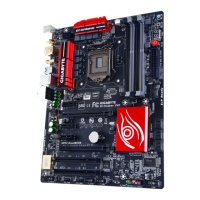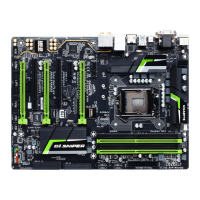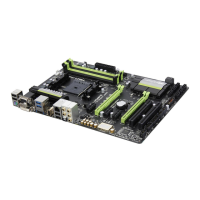Do you have a question about the Gigabyte G1.Sniper M3 and is the answer not in the manual?
Crucial safety guidelines and procedures for safe hardware installation to prevent damage.
Comprehensive technical details of the motherboard's components, slots, and connectivity options.
Step-by-step instructions for correctly installing the CPU and its associated cooling solution.
Detailed guide on inserting DDR3 memory modules, including dual-channel configuration.
Instructions for inserting expansion cards into PCI Express slots and securing them.
Configuration steps for enabling multi-GPU setups like AMD CrossFireX or NVIDIA SLI.
Identification and description of all ports and connectors located on the motherboard's rear panel.
Identification and description of internal headers and connectors on the motherboard.
Overview of the initial GIGABYTE logo screen displayed during system startup.
Navigation guide for the BIOS Setup program's main interface, including 3D BIOS and standard menus.
Settings for monitoring and adjusting CPU/memory frequency, voltage, and temperature.
Configuration for system language, date, time, and access level within the BIOS.
Settings related to boot order, CPU advanced features, and display adapter selection.
Configuration options for integrated devices like SATA controllers, LAN, audio, and USB.
Options for managing system power states, wake-up events, and energy efficiency.
Functions for saving BIOS changes, loading defaults, and exiting the setup utility.
Step-by-step process for installing essential chipset drivers from the provided motherboard disk.
Guide to installing GIGABYTE utilities and other bundled software applications.
Overview of the driver disk's content descriptions for technical manuals.
Contact details for GIGABYTE headquarters and regional offices for support.
Displays basic system information like BIOS version and memory details.
Information on accessing the GIGABYTE website for the latest BIOS, drivers, and software.
Links to install recently developed GIGABYTE utilities and applications.
Instructions for using Xpress Recovery2 for system data backup and restoration.
Details on using Q-Flash and @BIOS for updating the motherboard's BIOS safely.
Guide to EasyTune 6 for system tuning, overclocking, and performance adjustments.
Instructions for enabling data sharing between computers on a network using Q-Share.
Setup guide for eXtreme Hard Drive (X.H.D) utility to configure RAID arrays.
Using Auto Green to save power by automatically suspending the system when Bluetooth is out of range.
Configuration steps for Intel Rapid Start Technology to improve system resume times.
Setting up Intel Smart Connect Technology for automatic data updates during sleep mode.
Guide to configuring Intel Smart Response Technology for SSD caching and performance.
Instructions for installing and configuring SATA hard drives, including RAID setup.
Guide to setting up 2/5.1 channel audio, Creative software, and S/PDIF output.
FAQ and troubleshooting procedure to resolve common system startup and hardware issues.
Information on regulatory compliance, RoHS, WEEE directives, and environmental responsibility.
Crucial safety guidelines and procedures for safe hardware installation to prevent damage.
Comprehensive technical details of the motherboard's components, slots, and connectivity options.
Step-by-step instructions for correctly installing the CPU and its associated cooling solution.
Detailed guide on inserting DDR3 memory modules, including dual-channel configuration.
Instructions for inserting expansion cards into PCI Express slots and securing them.
Configuration steps for enabling multi-GPU setups like AMD CrossFireX or NVIDIA SLI.
Identification and description of all ports and connectors located on the motherboard's rear panel.
Identification and description of internal headers and connectors on the motherboard.
Overview of the initial GIGABYTE logo screen displayed during system startup.
Navigation guide for the BIOS Setup program's main interface, including 3D BIOS and standard menus.
Settings for monitoring and adjusting CPU/memory frequency, voltage, and temperature.
Configuration for system language, date, time, and access level within the BIOS.
Settings related to boot order, CPU advanced features, and display adapter selection.
Configuration options for integrated devices like SATA controllers, LAN, audio, and USB.
Options for managing system power states, wake-up events, and energy efficiency.
Functions for saving BIOS changes, loading defaults, and exiting the setup utility.
Step-by-step process for installing essential chipset drivers from the provided motherboard disk.
Guide to installing GIGABYTE utilities and other bundled software applications.
Overview of the driver disk's content descriptions for technical manuals.
Contact details for GIGABYTE headquarters and regional offices for support.
Displays basic system information like BIOS version and memory details.
Information on accessing the GIGABYTE website for the latest BIOS, drivers, and software.
Links to install recently developed GIGABYTE utilities and applications.
Instructions for using Xpress Recovery2 for system data backup and restoration.
Details on using Q-Flash and @BIOS for updating the motherboard's BIOS safely.
Guide to EasyTune 6 for system tuning, overclocking, and performance adjustments.
Instructions for enabling data sharing between computers on a network using Q-Share.
Setup guide for eXtreme Hard Drive (X.H.D) utility to configure RAID arrays.
Using Auto Green to save power by automatically suspending the system when Bluetooth is out of range.
Configuration steps for Intel Rapid Start Technology to improve system resume times.
Setting up Intel Smart Connect Technology for automatic data updates during sleep mode.
Guide to configuring Intel Smart Response Technology for SSD caching and performance.
Instructions for installing and configuring SATA hard drives, including RAID setup.
Guide to setting up 2/5.1 channel audio, Creative software, and S/PDIF output.
FAQ and troubleshooting procedure to resolve common system startup and hardware issues.
Information on regulatory compliance, RoHS, WEEE directives, and environmental responsibility.
| ECC | No |
|---|---|
| Non-ECC | Yes |
| Memory voltage | 1.5 V |
| Memory channels | Dual-channel |
| Number of memory slots | 4 |
| Supported memory types | DDR3-SDRAM |
| Maximum internal memory | 32 GB |
| Supported memory clock speeds | 1066, 1333, 1600 MHz |
| Supported memory module capacities | 16GB, 1GB, 2GB, 4GB, 8GB |
| System bus rate | 5 GT/s |
| Processor socket | LGA 1155 (Socket H2) |
| Processor manufacturer | Intel |
| Compatible processor series | Intel Core i3, Intel Core i5, Intel Core i7 |
| Maximum number of SMP processors | 1 |
| USB 2.0 connectors | 3 |
| Number of SATA III connectors | 2 |
| Number of Parallel ATA connectors | 0 |
| Headphone outputs | 5 |
| USB 2.0 ports quantity | USB 2.0 ports have a data transmission speed of 480 Mbps, and are backwards compatible with USB 1.1 ports. You can connect all kinds of peripheral devices to them. |
| Audio chip | Creative CA0132 |
| Cooling type | Passive |
| Component for | PC |
| Power source type | ATX |
| Motherboard chipset | - |
| PC health monitoring | CPU, FAN, Temperature |
| Audio output channels | 7.1 channels |
| Motherboard form factor | micro ATX |
| RAID levels | 0, 1, 5, 10 |
| Supported storage drive interfaces | SATA II, SATA III |
| Cables included | SATA |
| Graphics card | HD Graphics |
| OpenGL version | 3.2 |
| DirectX version | 11 |
| Maximum graphics card memory | 1696 MB |
| Parallel processing technology support | 2-Way SLI |
| PCI Express slots version | 3.0 |
| Controller interface type | Intel Z77 |
| Wi-Fi standards | Not supported |
| Networking features | 10/100/1000 Mbit/sec |
| Ethernet interface type | Gigabit Ethernet |
| BIOS type | EFI AMI |
| ACPI version | 2.0a |
| BIOS memory size | 64 Mbit |
| Width | 244 mm |
|---|
